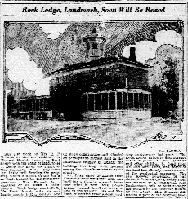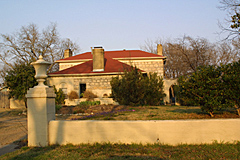|

Fragment from an 1852 map
(click on map for larger view)
|
On this 1852 map the red dot marks where the version of the Ridge Route cutting inside Coombes Creek
reached the top of the escarpment slope. From there travelers coming from the south could see, for the first time during their journey,
the valley of the Trinity River, below. They could have camped there if they needed to wait for floods to subside.
Abundant fresh water at Kidds Springs (originally known as Gilberts Springs) was nearby.
From this hilltop crossroads, one trail turned east to the rock-bottom crossing of the Trinity River that John Neely Bryan
selected as his site for Dallas, and another trail continued north across the broad flood-plain.
Today at 1622 Cedar Hill Avenue stands the Rock Lodge, built in the 1870s, which is (as far as I am able to ascertain) the
oldest surviving masonry structure within the city limits of Dallas.
The site of Rock Lodge is even older than the stone house – it makes a good candidate for being the possible site
of Mabel Gilbert’s 1842 cabin (if the Gilberts built on this side of the Trinity) and/or shortly thereafter,
W.P. Overton’s horse drawn grist-mill (the first in Dallas County).
During the 1950s neighbors called this stone house “the old Stagecoach Inn” and its location would have made it an ideal spot for stage coach lines
to set up a way-station.
Though the earliest area of permanent White Settlement in Oak Cliff, for various reasons few other structures
were built in this district until after World War II.
|

Rock Lodge in 1926
The Dallas Morning News
(click on image for larger view)
|
The massive Rock Lodge was built by S.A. Rush during the 1870s, using nearby stone.
For many years Rush was well known in the area, and on the southeast corner of West Davis and North Tennant Streets he established
Rush Chapel, a little country Methodist church that served as forerunner of today's Tyler Street Methodist Church.
When this 1926 photograph was taken the Rock Lodge was being used as a chicken-dinner restaurant, with
a long dining porch viewing downtown Dallas below. Contrary to the newspaper report, the
Rock Lodge was never demolished, but not long after this photograph was taken the wonderful central cupola (then in a state of decay) was removed.
1925 Newspaper obituary of S.A. Rush: (Click here).
|

Rock Lodge in 2002
(click on photo for larger view)
|
The Rock Lodge was extensively remodeled around 1930. Though the original design faced the house eastward,
the rear kitchen wing became the current front. Today the "Rock Lodge" remains a private residence. Various additions and restorations have been made over the years.
There have been numerous rumors of archaelogical relics unearthed in the surrounding yards.
|